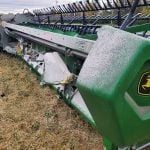
Tag Archives sclerotinia

Powdery mildew can be combine fire risk
Dust from the disease can ignite to cause combine fires; producers advised to frequently clean their equipment

Good news, bad news for fungicides meant to fight stem rot in canola
A report lays out various levels of resistance and adaptation found in disease samples

In disease resistance, sunflowers don’t shine
Practical Research: Insects don’t often hit economic thresholds, but sclerotinia and other diseases do damage

Pioneer levels up against sclerotinia
Corteva’s new canola hybrid delivers fungicide-equivalent protection

Canola’s least wanted
Experts discuss pests and pathogens canola growers will want to watch for in 2024

Sclerotinia control in canola
Growing hybrid varieties with improved disease resistance and other agronomic benefits can help protect your yields

Keep tabs on crop disease risk
Even the occasional rain event during a dry growing season can stimulate a crop disease outbreak

And the canola disease surveys say…
The 2020 numbers on blackleg, sclerotinia stem rot, clubroot, verticillium stripe and others across the Prairies

Crop disease experts take stock of 2020
Your provincial roundup of pulse and soybean diseases, what to watch for this year and emerging threats

What were the canola yield robbers in 2020?
Some farmers benefited from the environmental conditions while others were ready to put 2020 behind them


